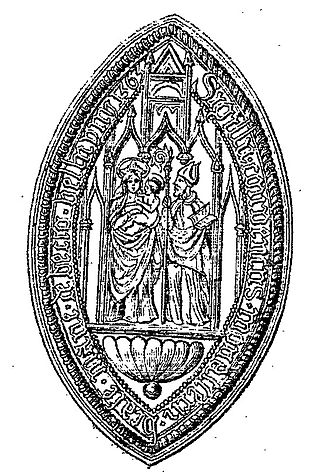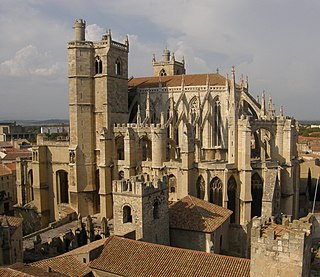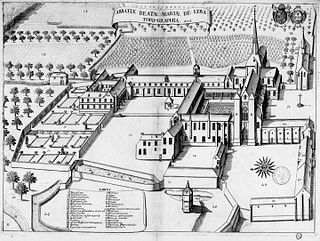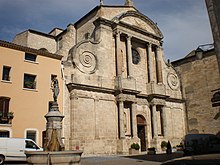
Bec Abbey, formally the Abbey of Our Lady of Bec, is a Benedictine monastic foundation in the Eure département, in the Bec valley midway between the cities of Rouen and Bernay. It is located in Le Bec Hellouin, Normandy, France, and was the most influential abbey of the 12th-century Anglo-Norman kingdom.

Benedict of Aniane, born Witiza and called the Second Benedict, was a Benedictine monk and monastic reformer who had a substantial impact on the religious practice of the Carolingian Empire. His feast day is either February 11 or 12, depending on the liturgical calendar.

William of Gellone, the medieval William of Orange, was the second Duke of Toulouse from 790 until 811. In 804, he founded the abbey of Gellone. He was canonized a saint in 1066 by Pope Alexander II.

Villemagne-l'Argentière is a commune near Bédarieux in the Hérault department in the Occitanie region in southern France.

The Diocese of Nice is a Latin diocese of the Catholic Church in France. The diocese comprises the Department of Alpes-Maritimes. The diocese is a suffragan of the Archdiocese of Marseille.

The former French Catholic Archbishopric of Arles had its episcopal seat in the city of Arles, in southern France. At the apex of the delta (Camargue) of the Rhone River, some 40 miles from the sea, Arles grew under Liburnian, Celtic, and Punic influences, until, in 46 B.C., a Roman military veteran colony was founded there by Tiberius Claudius Nero, under instructions from Julius Caesar. For centuries, the archbishops of Arles were regional leaders in creating and codifying canon law, through councils and synods.

The Diocese of Orléans is a Latin Church diocese of the Catholic Church in France. The diocese currently corresponds to the Départment of Loiret. The current bishop is Jacques André Blaquart, who was appointed in 2010.

The Metropolitan Archdiocese of Montpellier (–Lodève–Béziers–Agde–Saint-Pons-de-Thomières) is a Latin archdiocese of the Catholic Church in south-western France. The current metropolitan archbishop is Pierre-Marie Carré; the immediate past Archbishop Emeritus is Guy Marie Alexandre Thomazeau. On September 16, 2002, as part of the reshuffling of the map of the French ecclesiastical provinces, the diocese of Montpellier ceased to be a suffragan of Avignon and was elevated to archdiocese and metropolitan of a new ecclesiastical province, with the dioceses of Carcassonne, Mende, Nimes and Perpignan–Elne as suffragans.

The former Catholic diocese of Narbonne existed from early Christian times until the French Revolution. It was an archdiocese, with its see at Narbonne, from the year 445, and its influence ran over much of south-western France and into Catalonia.
The former French Catholic diocese of Alet was created in 1317 from territory formerly in the diocese of Narbonne. The diocese continued until the French Revolution when it was suppressed by the Concordat of 1801.

The former French Roman Catholic Diocese of Saint-Papoul, now a Latin titular see, was created by Pope John XXII in 1317 and existed until the Napoleonic Concordat of 1811.

The former French Catholic diocese of Saint-Pons-de-Thomières existed from 1317 until the French Revolution. Its see at Saint-Pons-de-Thomières in southern France is in the modern department of Hérault. There was the Abbey of St-Pons, founded in 936 by Raymond, Count of Toulouse, who brought there the monks of St-Géraud d'Aurillac.

The Roman Catholic Diocese of Béziers was situated in France. It is no longer an independent diocese, and is part of the Diocese of Montpellier.

The Archdiocese of Toulouse is a Latin Church ecclesiastical territory of the Catholic Church in France. The diocese comprises the Department of Haute-Garonne and its seat is Toulouse Cathedral. Archbishop Guy de Kerimel has been its head since 2021.

The ancient residential diocese of Orange in the Comtat Venaissin in Provence, a fief belonging to the papacy, was suppressed by the French government during the French Revolution. It was revived in 2009 as a titular see of the Catholic Church.
Richard de Millau (Milhau) was an 11th-century Cardinal and a major player in the Gregorian reform implemented in the South of France at the turn of the eleventh and twelfth centuries.

Raymond de Canillac was a French lawyer, bishop, and cardinal. He was born at Roche de Canilhac, the family castle, in the diocese of Mende in the Gevaudan in central France, the son of Guillaume de Canillac and a sister of Cardinal Bertrand de Déaulx. Both of his uncles, Pons and Guy, were successively abbots of Aniane, as was a nephew of the Cardinal, also called Pons. In 1345 his niece Garine, the daughter of his brother Marquis and of Alixène de Poitiers-Valentinois, married Guillaume Roger, Vicount of Beaufort, the brother of Cardinal Pierre Roger de Beaufort, who became Pope Clement VI. Raymond became a member of the Canons Regular of Saint Augustine (CRSA). He studied law at the University of Montpellier, and obtained the degree of Doctor in utroque iure.

Lyre Abbey was a monastery in Normandy, founded in 1046 at what is now the village of La Vieille-Lyre. From the mid-12th century it was a Benedictine house. It was abolished at the French Revolution and the abbey buildings mostly destroyed.
Rostang of Arles was Archbishop of Arles from 870 to 913. He supported the coup d'état of Boso of Provence against the Carolingians in 879.

Aurillac Abbey, otherwise the Abbey of Saint Gerald, Aurillac, founded around 895 in Auvergne by Count Gerald of Aurillac, destroyed during the French Wars of Religion and suppressed with the Revolution, was one of the oldest Benedictine abbeys, and probably influenced, in its arrangements and organization, the foundation of Cluny itself.


















